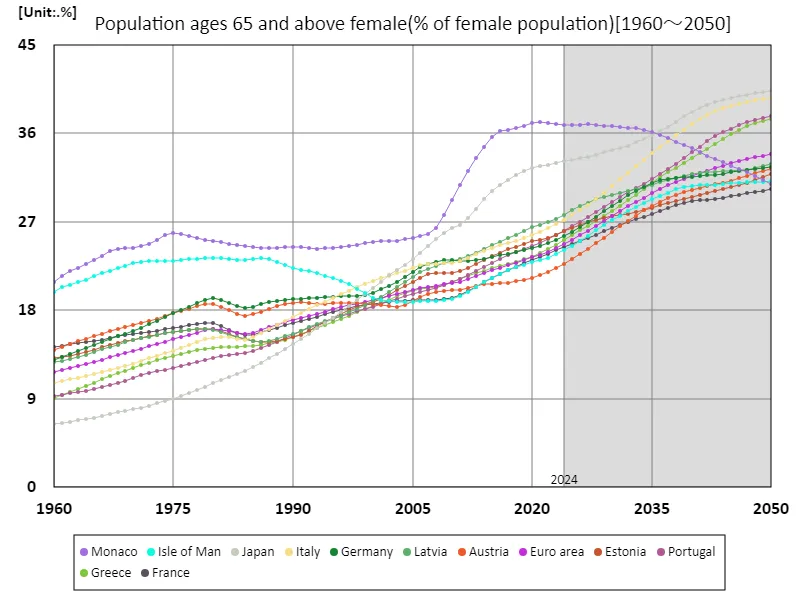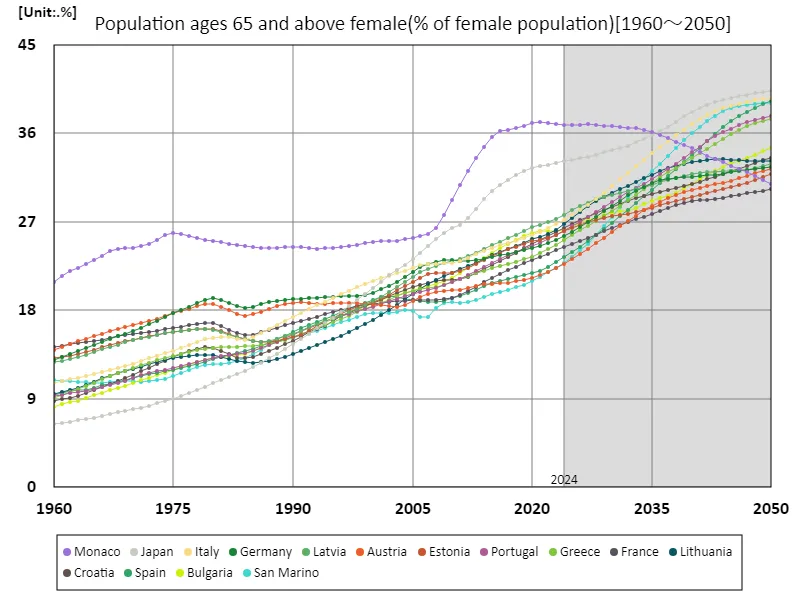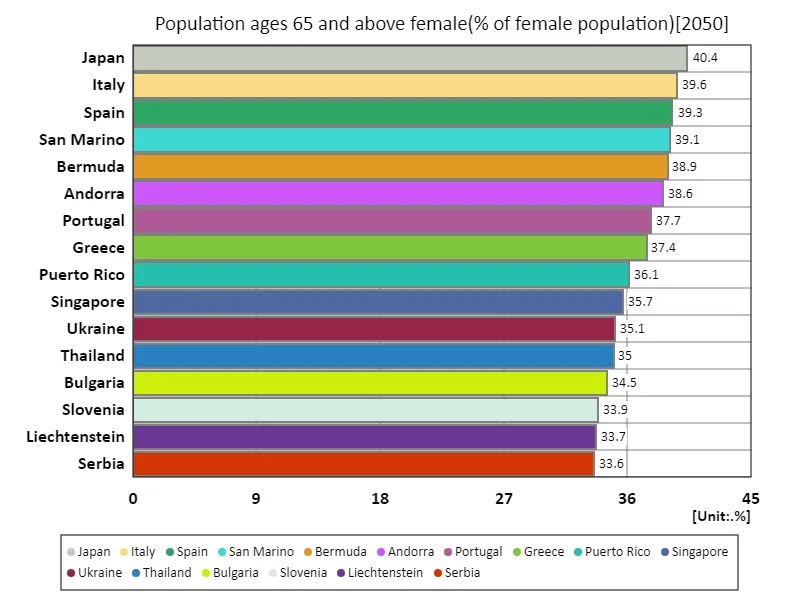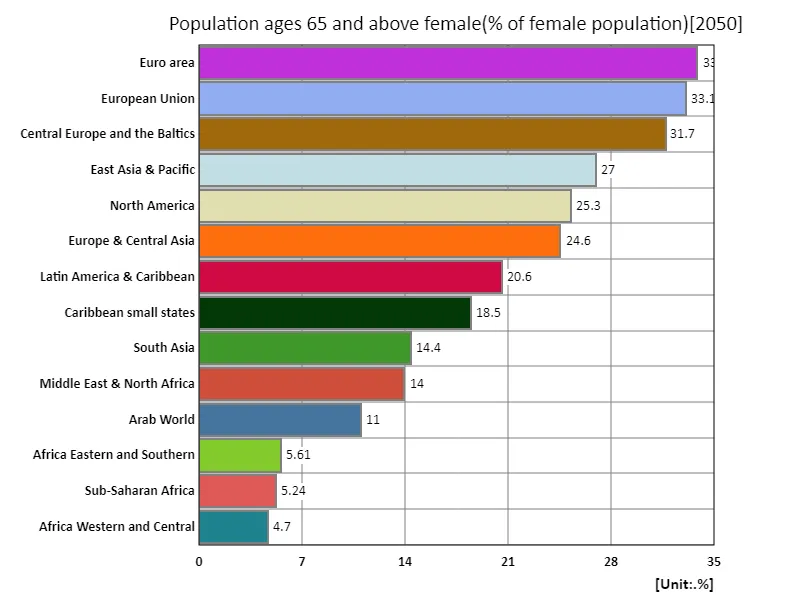- Abstract
- Female population aged 65 and over (female population ratio)
- Female population aged 65 and over (female population ratio) (Worldwide)
- Female population aged 65 and over (female population ratio) (Worldwide, latest year)
- Female population aged 65 and over (female population ratio) (region, latest year)
- Reference
Abstract
The proportion of the female population aged 65 and over is an important indicator of the progression of an aging society. According to the latest data, Japan is expected to have the largest share at 40.4% in 2050. This indicates that Japan is one of the countries with the most rapidly aging population. This trend is primarily driven by declining birth rates and increasing life expectancy. Japan’s aging population has progressed more rapidly than during the postwar period of rapid economic growth. Since the 1970s, birth rates have been falling, resulting in a decline in the younger age group, while medical advances and improving living standards are helping older people live longer. This has resulted in an increase in the proportion of the population aged 65 and over. In addition, aging is also progressing in other developed countries, and Japan is at the forefront of this trend. For example, European countries and South Korea are also experiencing significant aging, but the proportion is not as high as in Japan. Against this background, social security and labor issues will become even more important in the future. In order to respond to the aging society, there is a need to review the pension and medical systems and reform the labor market.
Female population aged 65 and over (female population ratio)
Between 1960 and 2050, the proportion of females aged 65 and over will increase significantly. In particular, Japan is expected to record the world’s highest ratio at 40.4% in 2050, indicating an extreme progression of aging. In the 1960s, the proportion of elderly people in Japan was relatively low, but has since risen sharply. The main factors are declining birth rates and medical advances. Japan’s aging population became more noticeable in the 1970s, when the birth rate began to decline along with the country’s rapid postwar economic growth. Increased life expectancy and improvements in medical technology are supporting the longevity of the elderly, which is contributing to an increase in the proportion of elderly people. The aging of the population progressed particularly rapidly from the 1990s to the 2000s, calling for a societal response. Japan’s case is having an impact on other countries, with South Korea and China also showing similar signs of aging, but the progression is not as rapid as in Japan. This will make reforms to the social security system and labor market essential, and will have a major impact on future policy formation. Japan’s aging population is an important indicator for the future structure of the global economy and society.


The maximum is the latest one, 40.4% of Japan
Female population aged 65 and over (female population ratio) (Worldwide)
Between 1960 and 2050, the proportion of females aged 65 and over will increase significantly. Japan in particular is predicted to experience extreme aging, with women aged 65 and over accounting for 40.4% of the total female population in 2050. This data shows that Japan is at the forefront of the ageing society trend. In the 1960s, the proportion of women aged 65 or over in Japan was relatively low, but since the 1970s, the declining birth rate and advances in medical technology have led to a rapid aging of the population. Japan’s aging population has progressed rapidly, especially since the 1990s, making it unique in the world. Longer life expectancy among the elderly combined with low birth rates has led to an increasing proportion of women aged 65 and over. If we take Japan’s peak ratio (100%) as the standard, the current rate of aging is at a very high level. This has highlighted major challenges to the social security system, medical costs, and labor market structure, making future policies even more important. Japan’s aging population will serve as an important reference case for other developed countries and will likely have an impact on the global economy and social systems in the future.


The maximum is the latest one, 40.4% of Japan
Female population aged 65 and over (female population ratio) (Worldwide, latest year)
According to data for 2050, the proportion of females aged 65 and over will be highest in South Korea at 42.4%, compared to an overall average of 18.8%. This makes South Korea one of the most rapidly ageing countries in the world. The combined ratio of 3.71k% indicates the impact of ageing in each country and highlights the rapid increase in the elderly population in international comparison. The notable trends since 1960 have been a decline in birth rates and an increase in life expectancy. In particular, South Korea has experienced rapid economic growth and improved living standards since the 1960s, which has led to accelerated aging along with medical developments. While birth rates are falling sharply, medical advances are extending the lifespan of older people, causing the proportion of women over 65 to soar. While Japan and European countries are also experiencing an aging population, the speed of aging in South Korea is particularly rapid. The background to this is the change in lifestyle that comes with economic development and social change. Future challenges will require reform of the social security and healthcare systems, as well as responses to the labor market, and international cooperation and strategic policies are needed to address these issues.


The maximum is 40.4% of Japan, the average is 18.8%, and the total is 3.66k%
Female population aged 65 and over (female population ratio) (region, latest year)
Data for 2050 shows that the proportion of women aged 65 and over will be highest in the euro area at 33.9%, compared to an overall average of 18.2%. The total, 272% of the total, represents the combined proportion of the female population aged 65 and over in all countries surveyed, indicating the seriousness of the aging population. The trend to date has been that aging of the population has progressed particularly rapidly in developed countries. In many developed countries, including the euro area, the proportion of the population aged 65 and over is increasing rapidly due to falling birth rates and advances in medical technology. In the euro area, post-war economic growth has been accompanied by increased life expectancy and declining birth rates. Particularly in countries like France, Germany and Italy, the proportion of elderly people is increasing, putting increasing pressure on social security and health systems. The average of 18.2% also reflects the overall progression of aging, making social system reform particularly urgent in countries where aging is progressing. As the population ages, important issues include the sustainability of the pension system, rising medical costs, and changes in the labor market. In order to address these challenges, we are now in an era in which each country is required to review its policies and seek international cooperation.


The maximum is 33.9% of Euro area, the average is 18.2%, and the total is 272%



Comments